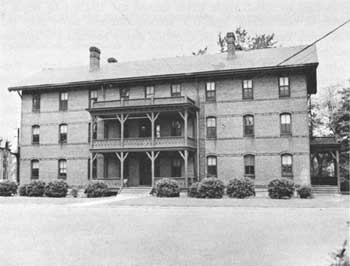





Survey of Historic Sites and Buildings
 |
HAMPTON INSTITUTE Virginia |
 |
| ||
This private school is primarily significant in the growth of black education and culture in the United States, a topic treated in other volumes of this series, but for many years it also educated small groups of Indians. Founded as the Hampton Normal and Industrial Institute in 1868 by Gen. Samuel C. Armstrong, a white whose interest in black education was stimulated while leading a colored regiment during the Civil War, it became a model for the numerous black normal and industrial schools subsequently established. It also influenced Lt. Richard H. Pratt in his founding of Carlisle Indian School, Pa.
 |
| The "Wigwam," Hampton Institute. (Hampton Institute) |
In 1878 a group of about 17 young Indians who had been released as prisoners of war from Fort Marion, Fla., began to attend Hampton, the only school that had responded to Pratt's appeal for their further education under Government auspices. That same year Pratt recruited 49 additional Indians in the West, including 9 girls. Indians attended the school until 1923, though the Government discontinued appropriations in 1912. Hampton's distinguished alumnus Booker T. Washington returned to his alma mater in 1879-81 as secretary to Armstrong, and among his duties in 1880 took charge of the Indian dormitory.
Numerous buildings on the campus date from the 19th century. Pertinent to Indian education is the Wigwam, erected in 1878 to house the students from Fort Marion. A museum in the Administration Building is devoted to Indian cultural displays, contributed mainly by ex-students.
NHL Designation: 05/30/74
 |
 |
http://www.cr.nps.gov/history/online_books/soldier-brave/siteb35.htm
Last Updated: 19-Aug-2005